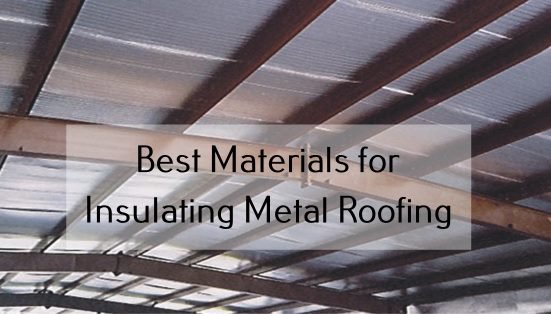In recent years, metal roofing has gradually increased in popularity for various reasons. It not only looks exquisite, but it also has more longevity than most roofing types, such as asphalt shingles.
Just because it’s a solid roof, it doesn’t automatically mean it doesn’t require any insulation. By insulating a metal roof, its energy efficiency can be maximized, making proper insulation a key aspect of installation.

Materials for Insulating Metal Roofing
Nearly all of the roofing structures need insulation, and there are much fewer metal roofs. Many residential and industrial buildings insulate the roofing structures to improve energy efficiency and lower noise emissions.
By insulating a metal roofing, you will have a warm and cozy home.
There are many options regarding the insulation materials that can be used to insulate metal roofs.
There are numerous metal roof insulation options regarding the materials that can be used, each with its unique benefits and drawbacks.
1. Spray Foam
For insulating under metal roofing, you can mix this spray foam with water, which can be applied by high-pressure spray devices.
The polyurethane foam will spread and solidify in just a few minutes when the mixture reacts with the O2, and the liquid dries up, resulting in rigid and thick foam.

Pros:
- Spray foam is the ideal choice if you want to insulate some areas with unusual shapes.
- Spray foam is one of the optimal options for metal roofing and can be used without hassle.
- Either on old or brand new metal roofs, spray foam can be installed on both without damaging the roofs.
- It’s great to prevent any condensation or infestations of rodents and insects.
Cons:
- Spray foam can sometimes be difficult to mount, so it would be best to leave it to the professionals.
2. Rigid Board
This material is not only great for insulating metal roofs but also for foundations and walls. It is made of polyurethane or polystyrene and usually comes in panels or sheets of various sizes.

Pros:
- Some people insulate metal roofing with rigid foam because it offers high thermal resistance when the panels are tightly sealed.
- In comparison to the other materials, the rigid board is way thinner and denser. Therefore, it can be mounted with fewer gaps, which greatly reduces any leakage.
Cons:
- The rigid board must be installed properly because UV rays can damage the material.
3. Fiberglass
Fiberglass is made of glass that is used in glassware. This material is woven and mixed with other materials, resulting in a thick insulating sheet that protects your roofing system.

Pros:
- Fiberglass is one of the most affordable and effortless ways to protect a metal roof.
- It is highly versatile, meaning it can be cut according to needs. It can also be placed above or under the metal roof sheets.
Cons:
- This material is not very safe to use by an inexperienced person because the shards of glass could harm your hands if you aren’t careful.
Additional Insulation Types
Besides the common types mentioned above, other options like closed-cell and open-cell spray foam offer distinct advantages in terms of thermal insulation and moisture resistance. Closed-cell insulation, in particular, is excellent for external applications due to its impermeability.
Rigid board insulation and foam board insulation are also highly effective, particularly for reducing noise and enhancing the thermal envelope of a building. Choosing the right type of insulation depends on the specific needs of the building and the climate.
Conclusion
Each material for roofing insulation has its own set of pros and cons. If you have never installed insulation and want to avoid damaging your roof, calling professionals is the best course of action.


